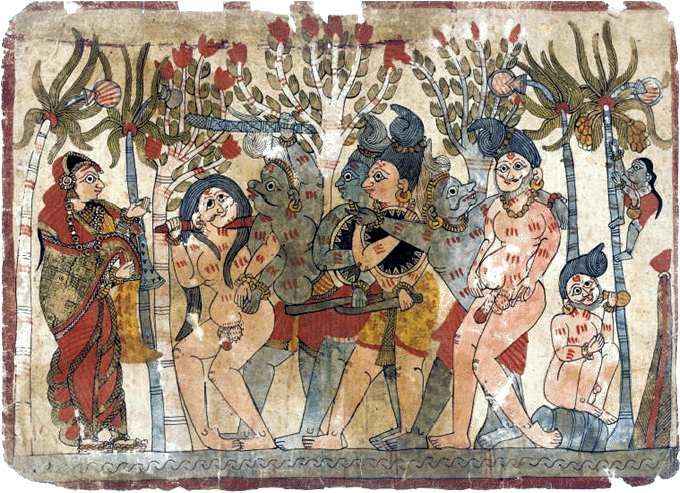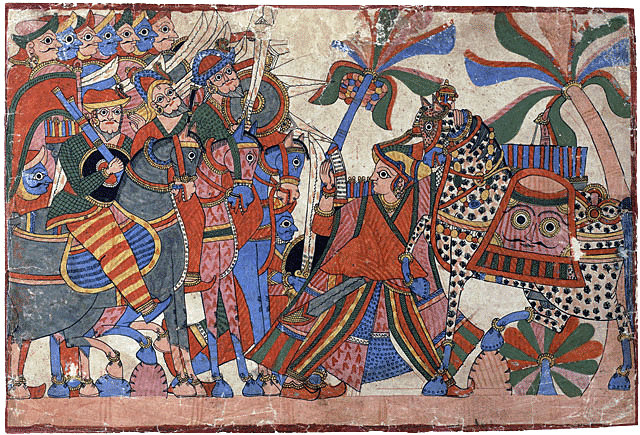
|
|
|
|
BY: SUN STAFF

Illustration from Ramayana Jun 06, 2017 — CANADA (SUN) — A serial exploration of the island of Jambudvipa and the sixteen Great States residing there.
The Magadha Kingdom
The Kingdom of Magadha was one of the most prominent and prosperous of ancient India's sixteen mahajanapadas. The kingdom roughly corresponds to the modern districts of Patna and Gaya in southern Bihar and parts of Bengal in the east.
The capital city, Pataliputra (modern Patna) was situated near several major rivers, bounded on the north by the Ganges, to the east by the river Champa, on the south by the Vindhya mountains and in the west by the river Sona. During Buddha's time its boundaries included Anga.
Magadha rose to prominence under a number of dynasties, peaking during the reign of Asoka Maurya, one of India's most legendary emperors. According to the Puranas, the Magadha Empire was established by the Brihadratha Dynasty, which was sixth in line from Emperor Kuru of the Bharata dynasty through his eldest son, Sudhanush. The first prominent Emperor of the Magadhan branch of the Bharathas was Emperor Brihadratha. Mahabharatha mentions that his son, Jarasandha, was slain by Bhima. The Vayu Purana mentions that the Brihadrathas ruled for 1,000 years.
The Brihadrathas were succeeded by the Pradyotas who, according to Vayu Purana, ruled for 138 years. The Pradyotas also ruled over another of the sixteen mahajanapadas, Avanti, but conquered Magadha for only this short span. One of the Pradyota traditions was for the prince to kill his father to become king. During the Pradyotas' rule, crimes were commonplace in Magadha. Tired of the dynastic feuds and crimes, the people rose up in civil revolt and elected Haryanka to become the king. This led to the emergence of the Haryanka dynasty.
Magadha's earliest capital was Girivraja or Rajagriha (modern Rajgir in Patna district). Other names for the city were Magadhapura, Brihadrathapura, Vasumati, Kushagrapura and Bimbisarapuri. It was an active center of Jainism in ancient times. The first Buddhist Council was held in Rajagriha in the Vaibhara Hills.
The alluvial plains of the Magadha region and its proximity to the iron rich areas of Bihar and Jharkhand allowed the kingdom to develop good quality weaponry and support their agrarian economy. These factors helped Magadha emerge as the most prosperous state of the period. Jain texts describe two weapons central to Magadha's defense: a catapult, and a covered chariot with swinging mace, that has been compared to a modern tank.

Sita restraining horsemen from battling her sons Over time Magadha expanded to include most of Bihar and Bengal, with the conquest of Licchavi and Anga, respectively. Later the kingdom dominated much of eastern Uttar Pradesh and Orissa. The ancient Kingdom of Magadha is heavily mentioned in Jain and Buddhist texts and also in the Ramayana, Mahabharata and Puranas. The earliest reference to the Magadha people occurs in the Atharva-veda, where they are listed along with the Angas, Gandharis, and Mujavats. Both the Maurya and Gupta Empires originated in Magadha. These ancient empires saw advancements in Vedic science, mathematics, astronomy, religion and philosophy, and represented a 'Golden Age' for India. There is little certain information available on the early rulers of Magadha. The most important sources are the Puranas, the Buddhist Chronicles of Sri Lanka, and other Jain and Buddhist texts, such as the Pali Canon. These sources indicate that Magadha was ruled by the Haryanka dynasty for some 200 years, circa 684 to 424 B.C. Siddhartha Gautama himself was born a prince of Kapilavastu in Kosala around the 5th Century B.C., during the Haryanka dynasty. Being the location of many incidents in Buddha's life, including his enlightenment, Magadha is often considered a blessed land. Starting in 424 B.C., the first of the Nine Nandas (Mahapadma and his eight sons) took power in the Magadha Kingdom, and that dynasty ruled for about 100 years. In 326 B.C. the army of Alexander approached the boundaries of Magadha, but the fighters refused to proceed. The army, exhausted and frightened at the prospect of facing another giant Indian army at the Ganges, mutinied at Hyphasis (modern Beas) and refused to march further East. Alexander, after taking counsel of his officer, Coenus, was persuaded to backtrack and turn south, thus Alexander pressed southward along the Indus, all the way to the ocean. Around 321 BC, the Nanda Dynasty ended and Chandragupta became the first king of the great Mauryan Empire, with the help of Vishnugupta. That Empire later extended over most of Southern Asia under King Asoka, who was at first known as 'Asoka the Cruel'. He later became a disciple of Buddhism and became known as Dhamma Asoka. After the Mauryan Empire ended the Sunga and Khaabela Empires followed, then the Gupta Empire began, remaining at Magadha's capital, Pataliputra. 
Illustration from Ramayana Sources: Mahabharata, Wiki, British Museum
| |